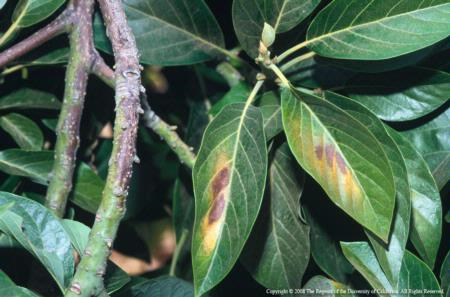
Posts Tagged: heat stress
When Plants Suffer, People Suffer Too
Reflections on Water – People and Trees
Coastal California is a hard environment to decide when to irrigate. Fog and rain vary from season to season and day to day. Depending on the proximity to the coast and elevation, average rainfall in Ventura is about 18 inches. That is the average of some years when we get over 40 inches with those when we get 4 inches. Below average is more the norm than above that figure. Late rains into June can happen, but the latest significant rains can also happen in January. So what is average? And based on rainfall, how do you know when to irrigate?
May grey/June gloom adds to the confusion of what might be an appropriate irrigation cycle. That cool, moist, low wind condition fog reduces water use by plants. Fog drip also adds soil moisture that the plant can use. But, as soon as the fog lifts, the wind kicks in and sucks out the soil moisture.
Water moves from the soil, though the roots, up through the plant stem and through the leaves. It's pulled by the conditions outside the leaf. The longer the air outside the leaf is dry, windy and warm, the more water is pulled out of the plant. And then the plant pulls it out of the soil to replace the water lost from the plant. It's called the cohesion-tension theory of water movement. Water molecules stick together and pull themselves along, the way a train locomotive pulls a string of freight cars. This happens whenever the conditions outside of the leaf are “drier” than inside the leaf. It happens in the winter and summer, when the soils are cold and when they are warm. It's a passive, physical process.
When plants lose water through their leaves, it's called transpiration. It's mediated by stomata in the leaves. These openings or pores are similar to the pores in our skin. People lose water off their skin and it's called evaporation or sweating. Water loss from leaves is similar to water loss from skin.
Evaporation from the skin and from leaves cools the surface. This cooling helps prevent heat stress. The leaf and skin both act as radiators. When this water loss stops, both plants and humans can go into heat stress. So water loss has an important function in both plants and humans. For plants, the stomata also need to be open in order to take in carbon dioxide to make sugar by way of photosynthesis.
The weather factors that drive water loss – water that needs to be replaced or the bodies begin to into heat stress – are the mount of light (day length, cloud cover), relative humidity (it dries faster when air is dry and it's slower when it's humid – think desert versus Florida), and windy (more wind, more drying). When water can't be delivered fast enough to the leaf, it wilts, when the human body starts drying out, the skin wrinkles and dries out. In both cases, water needs to be taken in to reverse the loss.
Temperature is important in water loss, but not as important or as much as the other drivers or humidity, day length and wind. When it's cold, leaves and skin both dry out – think freeze-drying, a very successful process for removing water from fresh food to make a light, backpacking food. Often humans respond more to temperature than these other driving factors of water loss. If it's cool, it's not necessary to irrigate the trees. A common grower refrain is, “it's winter, I don't need to irrigate.” After five years of drought, we know better about winter irrigation.
However, this “winter and it's cool, so it's not necessary to drink water while working outside” refrain is common, too. And this can be a real human health problem. Dehydration is something serious and we should all be aware of the need to drink water during these cool, windy days of spring.
Heat stress and irrigation are both more complicated than just being aware of the weather, but below are some helpful guidelines from Cal/OSHA to follow to avoid heat stress in humans. Hey, also might not be too far off for plants, as well.
https://www.dir.ca.gov/dosh/heatillnessinfo.html
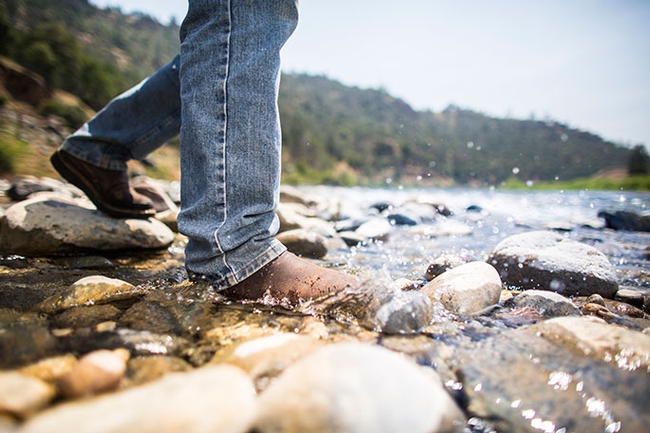
walking on water
It's NOT Just Heat Stress, It's Lack of Water for Cooling
Plants lose water through their leaves and it's called transpiration. People lose water off their skin and it's called evaporation or sweating. When a plant stops losing water and when people cant produce enough sweat to cool off, both overheat. The weather influences that drive this water loss - water that needs to be replaced or the bodies begin to go into heat stress - are the amount of light (day length, cloud cover), relative humidity (it dries faster when air is dry and slower when humid - think desert versus Florida), and windy (more wind, more drying). Temperature is important, but not as much as these other drivers. Think freeze-drying - a very successful process for removing water from food. Often humans respond more to temperature than these other factors and figure, when it's cool. it's not necessary to water their plants, themselves or their workers.
Heat stress is more complicated than this, of course, but below are some helpful guidelines to follow to avoid heat stress:
https://www.dir.ca.gov/dosh/heatillnessinfo.html
Cal/OSHA HEAT ADVISORY
When employees work in hot conditions, employers must take special precautions in order to prevent heat illness. Heat illness can progress to heat stroke and be fatal, especially when emergency treatment is delayed. An effective approach to heat illness is vital to protecting the lives of California workers.
California law requires employers to identify and evaluate workplace hazards and take the steps necessary to address them. The risk of heat illness can be significantly reduced by consistently following just a few simple steps. Employers of outdoor workers at temporary work locations must be particularly alert and also plan for providing first aid and emergency medical services should they become necessary. All workers should be accounted for during and at the end of the work shift. Heat illness results from a combination of factors including environmental temperature and humidity, direct radiant heat from the sun or other sources, air speed, and workload. Personal factors, such as age, weight, level of fitness, medical condition, use of medications and alcohol, and acclimatization effect how well the body deals with excess heat.
Heat Illness Risk Reduction
1. Recognize the Hazard. There is no absolute cut-off below which work in heat is not a risk. With heavy work at high relative humidity or if workers are wearing protective clothing, even work at 70oF can present a risk. In the relative humidity levels often found in hot areas of California (20 to 40 percent) employers need to take some actions to effectively reduce heat illness risk when temperatures approach 80 F. At temperatures above 90 F, especially with heavy work, heat risk reduction needs to be a major concern.
2. Water. There must be an adequate supply of clean, cool, potable water. Employees who are working in the heat need to drink 3-4 glasses of water per hour, including at the start of the shift, in order to replace the water lost to sweat. For an eight-hour day this means employers must provide two or more gallons per person. Thirst is an unreliable indicator of dehydration. Employees often need ongoing encouragement to consume adequate fluids, especially when the workload or process does not encourage breaks.
3. Shade. The direct heat of the sun can add as much as 15 degrees to the heat index. If possible, work should be performed in the shade. If not, employers where possible, should provide a shaded area for breaks and when employees need relief from the sun. Wide brimmed hats can also decrease the impact of direct heat.
- Acclimatization. People need time for their bodies to adjust to working in heat. This “acclimatization” is particularly important for employees returning to work after (1) a prolonged absence, (2) recent illness, or (3) recently moving from a cool to a hot climate. For heavy work under very hot conditions, a period of 4 to 10 days of progressively increasing work time starting with about 2 hours work per day under the working conditions is recommended. For less severe conditions at least the first 2 or 3 days of work in the heat should be limited to 2 to 4 hours. Monitor employees closely for signs and symptoms of heat illness, particularly when they have not been working in heat for the last few days, and when a heat wave occurs.
- Rest Breaks. Rest breaks are important to reduce internal heat load and provide time for cooling. Heat illness occurs due to a combination of environmental and internal heat that cannot be adequately dissipated. Breaks should be taken in cooler, shaded areas. Rest breaks also provide an opportunity to drink water.
- Prompt Medical Attention. Recognizing the symptoms of heat illness and providing an effective response requires promptly acting on early warning signs. Common early symptoms and signs of heat illness include headache, muscle cramps, and unusual fatigue. However, progression to more serious illness can be rapid and can include unusual behavior, nausea/vomiting, weakness, rapid pulse excessive sweating or hot dry skin, seizures, and fainting or loss of consciousness. Any of these symptoms require immediate attention.
Even the initial symptoms may indicate serious heat exposure. If medical personnel are not immediately available on-site, and you suspect severe heat illness, you must call 911.
Regardless of the worker's protests, no employee with any of the symptoms of possible serious heat illness noted above should be sent home or left unattended without medical assessment and authorization.
7. Training. Supervisors and employees must be trained in the risks of heat illness, and the measures to protect themselves and their co-workers. Training should include:
- Why it is important to prevent heat illness
- Procedures for acclimatization
- The need to drink approximately one quart per hour of water to replace fluids.
- The need to take breaks out of the heat
- How to recognize the symptoms of heat illness
- How to contact emergency services, and how to effectively report the work location to 911.
Photo: Heat Stress to avocado leaves.

heat damage to avocado leaves
When It Gets Hot, It Gets Confusing
So I got called out to see an orchard that had dieback. Over the phone it sounded like “Dothiorella Leaf Blight” (//ucanr.edu/blogs/blogcore/postdetail.cfm?postnum=10354). This symptom shows up when there has been water stress of some sort, over a period of a few weeks to months. 
It can be a branch or a whole tree. It usually is due to a watering schedule that doesn't meet the needs of the plant. It is exacerbated by competition from more aggressive plants nearby, like eucalyptus windbreaks. With increased competition over time, root rot can also start taking its toll because of the stress, as well. Where you see areas cleared of trees, and where there are struggling trees in various stages of survival, it's a good indication of a rough environment.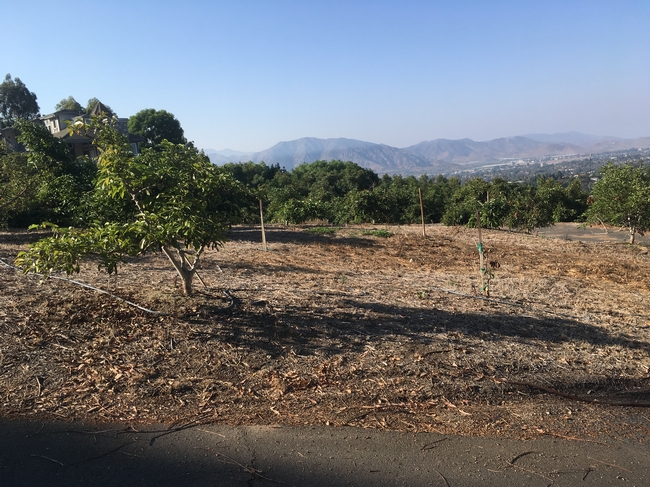
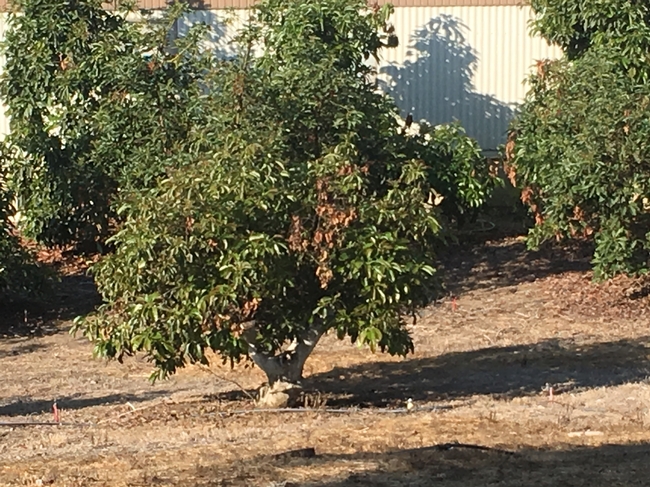
Trees with root rot symptoms may have been stumped previously, and with their weakened root systems are more prone to leaf blight.
In the case of this grove, it was at the top of the hill where it got all the wind and a full day's sun above the typical coastal fog.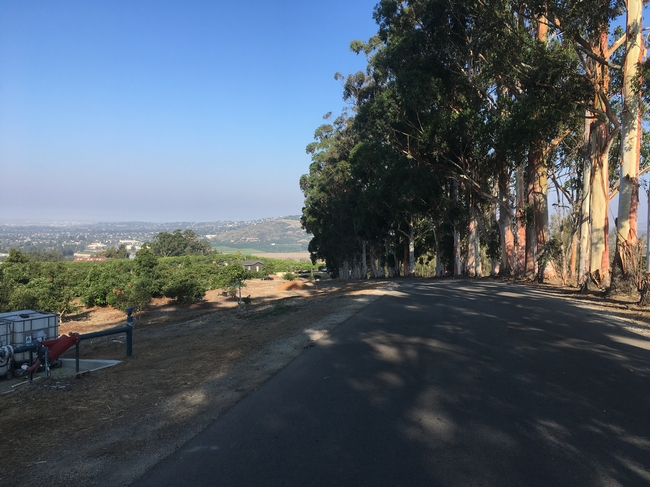
So the grower asked about the damage. There was the heat damage from the July heat wave.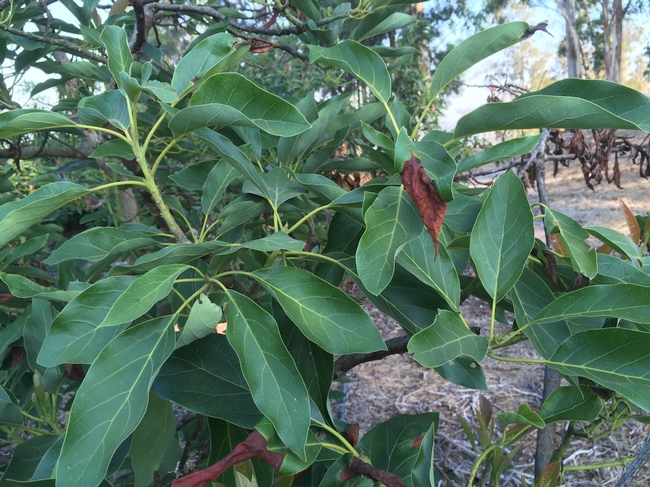
Then there was the damage that had showed up earlier, the leaf blight that was associated with the ongoing water stress. In a way, both of these symptoms are of water stress, one very rapid, hence the reddish tint to the leaves. The other a slower collapse, the leaf blight from prolonged water stress.
Over time, this type of stress had allowed root rot to take hold and trees were stumped in order to help them survive. The trees were also started on a regular phosphonate program. In general, the rest of the orchard looked good, except for this area near the competitive windbreak trees. The heat damage was mostly in this area, as well. The grower had been forewarned of the impending heat and irrigated the trees prior to the hard weather.
In the case of heat damage or blight, and leaf/stem blight, it's not fatal for mature trees. Younger trees under two years can be killed. They usually need whitewashing to prevent sun burn damage.
But even they can be revived if the watering is improved.
And Human Heat Stress
Cal/OSHA HEAT ADVISORY
When employees work in hot conditions, employers must take special precautions in order to prevent heat illness. Heat illness can progress to heat stroke and be fatal, especially when emergency treatment is delayed. An effective approach to heat illness is vital to protecting the lives of California workers.
California law requires employers to identify and evaluate workplace hazards and take the steps necessary to address them. The risk of heat illness can be significantly reduced by consistently following just a few simple steps. Employers of outdoor workers at temporary work locations must be particularly alert and also plan for providing first aid and emergency medical services should they become necessary. All workers should be accounted for during and at the end of the work shift. Heat illness results from a combination of factors including environmental temperature and humidity, direct radiant heat from the sun or other sources, air speed, and workload. Personal factors, such as age, weight, level of fitness, medical condition, use of medications and alcohol, and acclimatization effect how well the body deals with excess heat.
Heat Illness Risk Reduction
1. Recognize the Hazard. There is no absolute cut-off below which work in heat is not a risk. With heavy work at high relative humidity or if workers are wearing protective clothing, even work at 70oF can present a risk. In the relative humidity levels often found in hot areas of California (20 to 40 percent) employers need to take some actions to effectively reduce heat illness risk when temperatures approach 80 F. At temperatures above 90 F, especially with heavy work, heat risk reduction needs to be a major concern.
2. Water. There must be an adequate supply of clean, cool, potable water. Employees who are working in the heat need to drink 3-4 glasses of water per hour, including at the start of the shift, in order to replace the water lost to sweat. For an eight-hour day this means employers must provide two or more gallons per person. Thirst is an unreliable indicator of dehydration. Employees often need ongoing encouragement to consume adequate fluids, especially when the workload or process does not encourage breaks.
3. Shade. The direct heat of the sun can add as much as 15 degrees to the heat index. If possible, work should
be performed in the shade. If not, employers where possible, should provide a shaded area for breaks and when employees need relief from the sun. Wide brimmed hats can also decrease the impact of direct heat.
- Acclimatization. People need time for their bodies to adjust to working in heat. This “acclimatization” is particularly important for employees returning to work after (1) a prolonged absence, (2) recent illness, or (3) recently moving from a cool to a hot climate. For heavy work under very hot conditions, a period of 4 to 10 days of progressively increasing work time starting with about 2 hours work per day under the working conditions is recommended. For less severe conditions at least the first 2 or 3 days of work in the heat should be limited to 2 to 4 hours. Monitor employees closely for signs and symptoms of heat illness, particularly when they have not been working in heat for the last few days, and when a heat wave occurs.
- Rest Breaks. Rest breaks are important to reduce internal heat load and provide time for cooling. Heat illness occurs due to a combination of environmental and internal heat that cannot be adequately dissipated. Breaks should be taken in cooler, shaded areas. Rest breaks also provide an opportunity to drink water.
- Prompt Medical Attention. Recognizing the symptoms of heat illness and providing an effective response requires promptly acting on early warning signs. Common early symptoms and signs of heat illness include headache, muscle cramps, and unusual fatigue. However, progression to more serious illness can be rapid and can include unusual behavior, nausea/vomiting, weakness, rapid pulse excessive sweating or hot dry skin, seizures, and fainting or loss of consciousness. Any of these symptoms require immediate attention.
Even the initial symptoms may indicate serious heat exposure. If medical personnel are not immediately available on-site, and you suspect severe heat illness, you must call 911.
Regardless of the worker's protests, no employee with any of the symptoms of possible serious heat illness noted above should be sent home or left unattended without medical assessment and authorization.
7. Training. Supervisors and employees must be trained in the risks of heat illness, and the measures to protect themselves and their co-workers. Training should include:
- Why it is important to prevent heat illness
- Procedures for acclimatization
- The need to drink approximately one quart per hour of water to replace fluids.
- The need to take breaks out of the heat
- How to recognize the symptoms of heat illness
- How to contact emergency services, and how to effectively report the work location to 911.

sun stress
Avocado Heat Advisory
Avocado Heat Advisory Temperatures are forecast to be in the triple digit range throughout much of the southern California avocado growing region beginning Sunday June 19 and extending into Tuesday June 21. The National Weather Service (NWS) is predicting maximum temperatures between 100 and 110 degrees with similar heat index readings away from the immediate coast for Ventura and Los Angeles Counties. In Riverside, San Diego and Orange Counties, NWS predictions are for 95 to 105 degrees in the valleys, and 105 to 113 degrees in the inland empire and high desert.
To ensure that California avocados maintain their superior quality it is imperative that growers manage their trees and harvest their fruit according to the best management practices as outlined below.
IRRIGATION Growers should be irrigating their trees now, in advance of the heat, to ensure that their trees are fully hydrated. An additional 50% of the budgeted amount of water is recommended to be applied the day before a heat wave. For extended heat waves, daily pulses of irrigation are recommended to maintain the trees' water status. A well-watered tree will tolerate the stress of a heat wave much better than a tree that is suffering from water stress. Signs of heat damage to trees include fruit drop, shoot damage, leaf burn and in severe cases leaf drop.
HARVESTING Every attempt should be made to harvest fruit when temperatures are below 90 °F, and no harvesting should take place when temperatures exceed 95 °F. Temperature in the shade should be monitored during harvesting and, when possible, harvesting crews should be moved to the coolest, least exposed areas of the grove.
Field bins should be placed under the trees while being filled to protect the harvested fruit from sunburn. Once filled, bins should be moved to a shade structure (open-sided roofed building), or covered with bin covers or light-colored tarps if they cannot be immediately transported to the packinghouse. Never leave filled bins exposed to the direct sun. The surface layer of fruit can easily heat up to more than 15 °F above ambient temperature when exposed to direct sun. Acute sunburn will only show on fruit after it is packed and is a major quality detractor.
To avoid water loss and decreased fruit quality do not hold fruit too long after harvest. Transport fruit to the packinghouse at least once per day, if not twice daily. Bins should not be left in the grove for more than 8 hours after harvest. Cover bins during transport to avoid sunburn and to reduce water loss.
Photos: Leaf sunburn, fruit sunburn

avocado leaf sunburn

avocado fruit sunburn

